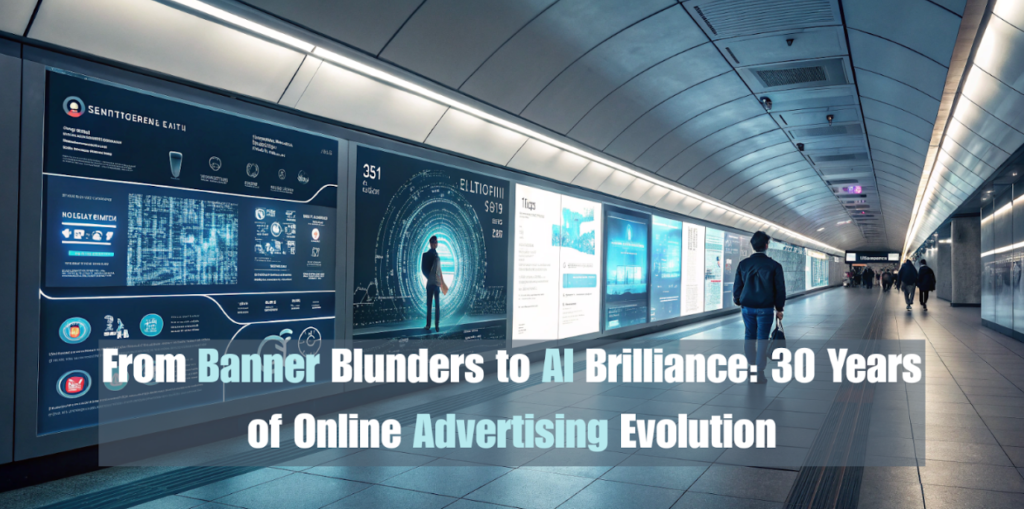It’s been three decades since the internet said, “Hey, fancy a click?” and online advertising has never looked back. From clunky banner ads that screamed for attention to AI-powered campaigns whispering directly into consumer intent, digital advertising has gone through a transformation that would make even Doctor Who raise an eyebrow.
1994: When Ads Met the Internet
It all started with a banner. Literally. The first-ever online advertisement was a simple, clickable banner launched by AT&T in 1994 on HotWired (now part of Wired magazine). The kicker? It boasted a whopping 44% click-through rate. A number today’s marketers can only dream of.
Was it design? Timing? Or just the novelty of it all? Who knows. But one thing was clear. Digital advertising had entered the chat.
The Search Engine Shuffle (Late ‘90s – Early 2000s)
As more brands went online, the chaos needed some sorting and that’s when search engine advertising took the spotlight. Platforms like GoTo.com (which eventually became Overture and later Yahoo! Ads) introduced the concept of pay-per-click (PPC) and keyword targeting, giving advertisers the power to place ads based on search intent.
This innovation laid the foundation for what Google would later turn into an empire with Google AdWords (now Google Ads).
The Programmatic Pivot
By the 2010s, the digital landscape was evolving faster than a caffeine-fuelled coder. Enter programmatic advertising. The automation of ad buying using algorithms and data in real-time. This was advertising’s version of going from a Nokia 3310 to an iPhone overnight.
Real-Time Bidding (RTB) became the go-to method for buying ad inventory, and demand-side platforms (DSPs) allowed brands to bid for impressions as users browsed the web.
The Rise of Social & Mobile Advertising
Social media brought with it a whole new world of possibilities (and distractions). Platforms like Facebook, Instagram, LinkedIn, and Twitter allowed brands to target audiences not just by interest, but by behaviour, mood, life milestones. You name it.
Meanwhile, the mobile-first movement made sure brands were quite literally in people’s pockets. With smartphones dominating the digital journey, mobile-optimised creatives and location-based targeting became non-negotiable.
2020s & Beyond: Advertising Gets a Brain
The past few years have seen the rise of AI and machine learning in online advertising. Campaigns can now adapt in real-time, creatives can be dynamically generated, and targeting is more laser-focused than ever.
Think of it as advertising with a sixth sense. Predicting what users want before they even Google it.
AI isn’t just a buzzword anymore. It’s the strategic heartbeat behind everything from personalised content recommendations to predictive bidding algorithms. If you’re not embracing it, your competitors likely are.
Where’s It All Headed?
Online advertising is no longer just about grabbing attention. It’s about holding it, nurturing it, and converting it. With the deprecation of third-party cookies, a greater focus on privacy, and the shift towards first-party data, the future belongs to those who prioritise authenticity, value, and intelligent targeting.
At iRebel, we believe:
- Great ads aren’t just seen, they’re remembered.
- Strategy beats spray-and-pray every time.
- AI is a tool, not a replacement for human creativity.
Looking to future-proof your digital strategy? Explore our performance marketing services. Or better yet, have a chat with our rebels.
Final Thoughts
From humble banners to brainy bots, online advertising has come a long way. But amidst all the evolution, one truth stands tall: People don’t hate ads, they hate bad ads. And that’s where we come in.At iRebel, we don’t just follow trends. We bend them, flip them, and make them work for your brand. Whether you’re tired of throwing ad money into the void or you’re ready to scale like a savage, we’ve got the strategy, sass, and stats to back it up.

